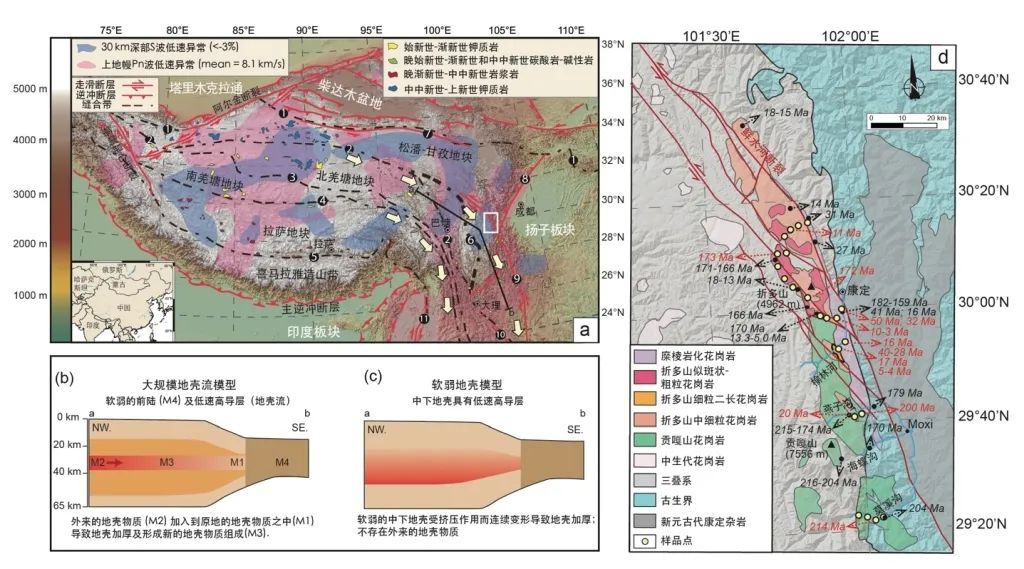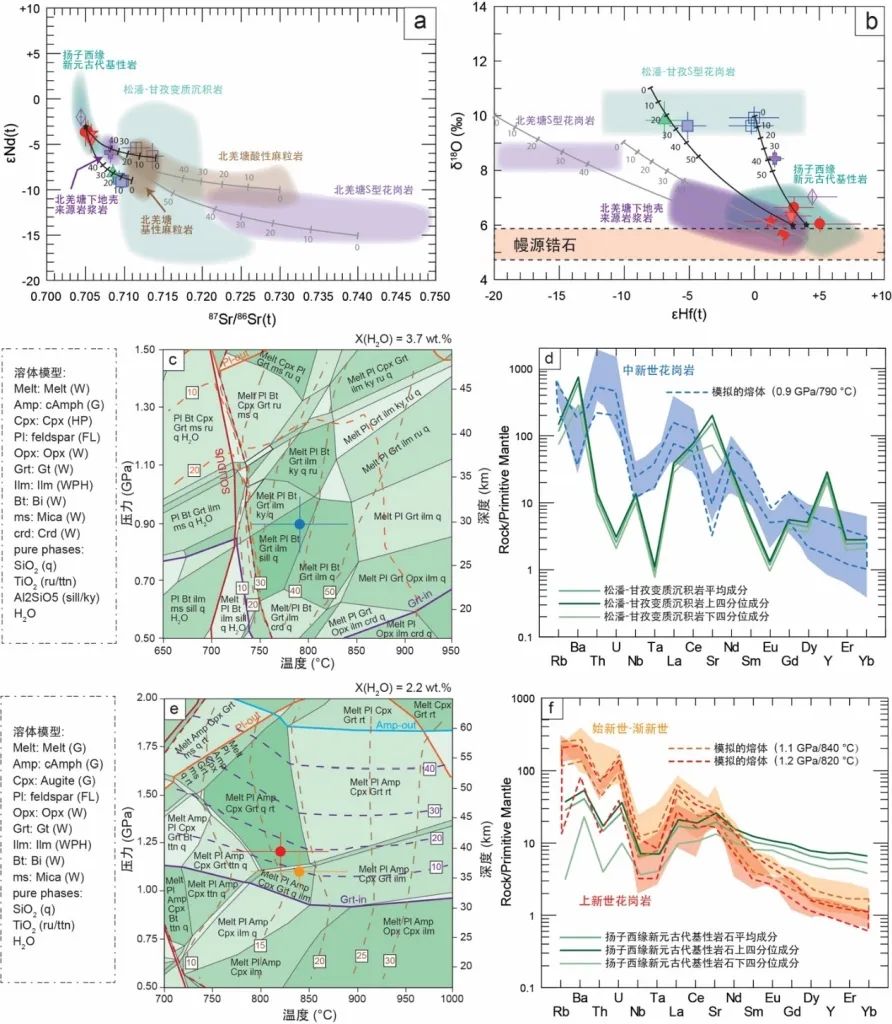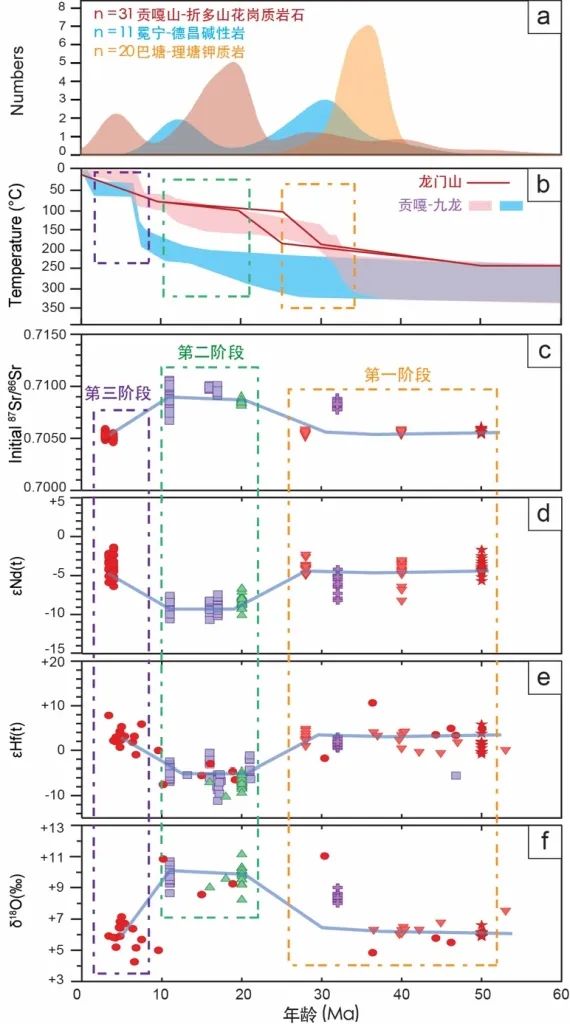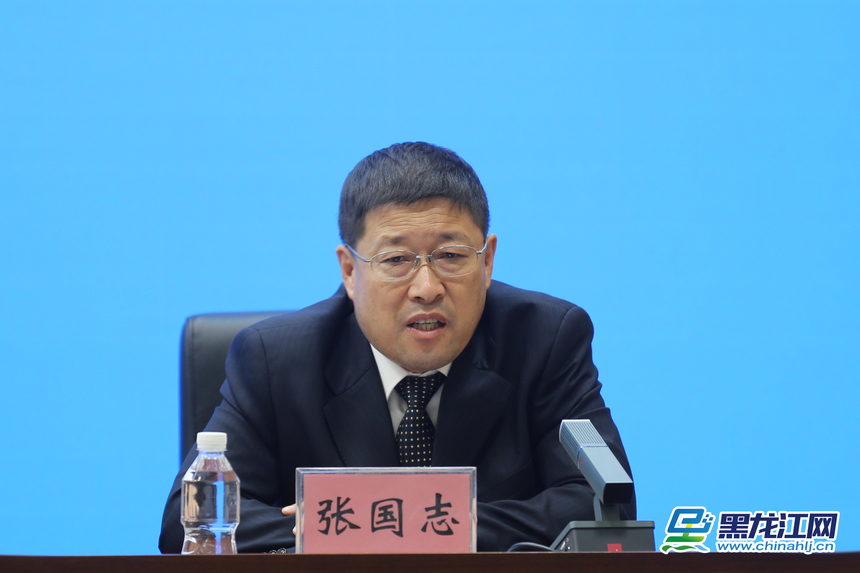Hu Fangyu et al. -Grl: Large-scale crustal flow has shaped the east of the Qinghai-Tibet Plateau?——Ins evidence of the effect of multi-phase magma effect on Gongga Mountain
Author:Institute of Geological Earth Time:2022.07.15


The Qinghai -Tibet Plateau, as a "roof of the world", has evolved, especially the internal crustal deformation, thickened dragon up, and expanding outward, which is the key content of the research in the field of earth science. Aiming at the special geological phenomenon of the east margin of the Qinghai -Tibet Plateau, such as a large -scale slip -to -fault, the significant crustal thickening and the lack of the new generation of the crust, the predecessors have proposed three classic geological models, which are rigid blocks squeezed out of the body. (TAPPONNIER ET AL., 1982), the continuous deformation of the rock ring (English and Houseman (1986), and the large -scale mid -down crust (Royden et al., 1997; Clark and Royden, 2000). Among them, the large -scale (& 1000km) mid -to lower crust flow has attracted widespread attention and support from many scholars in the past 20 years. The model believes that the crust thicker of the eastern edge of the Qinghai-Tibet Plateau is caused by the internal (Beiqiangtang plot) of the Tibetan Plateau in the depth of 25-40km to the east of the Qinghai-Tibet Plateau, and added to the eastern edge of the Qinghai-Tibet Plateau. The physical observation results of the earth show that there are extensive low -speed and high -conductors in the eastern edge of the Qinghai -Tibet Plateau and inside, and support the flow of middle and lower crustal substances (such as Bai et al., 2010; Wang et al., 2010; Bao et al., 2015 To. However, some scholars have questioned this that the model lacks geological evidence (Searle et al., 2016), and some research results in recent years do not seem to support this large -scale crustal flow (Wang et al., 2012; 2012; 2012; Zhang et al., 2016; bao et al., 2020).
According to the large-scale medium and lower ground shell flow model, the East Margin of the Qinghai-Tibet Plateau is a significant rise in the new generation of the new generation and the lack of crustal shortening deformation due to the crustal flow. According to the prediction of this model, the thickness and lifting of the crust should be completed at about 20 million years, so the start time of the crust flow should be between 30-40mA. Secondly, for the crustal flow model, the pressure gradient is the initial and necessary conditions formed by it, and the central part of the Qinghai -Tibet Plateau has a high altitude height (xu et al., 2013; Hu et al., 2020 ) So, during the beginning of the new period, there may be stress gradient between the central and east margin of the Qinghai -Tibet Plateau. In addition, the high -level floor temperature gradients with higher and east margins observed at present are also necessary conditions for forming large -scale crust flow. As a result, the conditions required for large -scale ground shell flows seem to be met.
In order to explore whether it is a large -scale crustal flow, the eastern edge of the Qinghai -Tibet Plateau, the key laboratory of Hu Fanghuan, a key laboratory of the Institute of Mineral Resource Research Institute of the Institute of Geology and Geophysics of the Chinese Academy of Sciences Professor MIAI N. DUCEA, Associate Professor James B. Chapman University of Wyoming University, and Dr. Yang Lei, Chengdu University of Science and Technology, etc. System research. This miscellaneous rock body is located above the large-scale crustal flow proposed by predecessors. According to the results of the previous research, the characteristics of the crust for the Beidang plot can be distinguished from the east margin of the Qinghai-Tibet Plateau (Songpan-Ganzi Land). Therefore, if the large scale of the internal material inside the crustal in the new generation flows eastward, because these granite rocks mainly come from part of the melting of the crust, the magma source area reflects the change of the source area of the magma (Figure 1).

Figure 1 The Geological Geology and Model Conceptual Picture of the Qinghai -Tibet Plateau and Gongga Mountain. The yellow arrow in the figure indicates the movement direction of the potential crust flow
After a detailed field survey and interior analysis, the research team found that Gongga Mountain-Zhenda Mountain invaded the heterosexual rock body to record the middle generation (215-172ma) and the new generation (50-3mA). Multi-phase magma effects, especially in the new generation, have three phases of magma, which are 50-30mA, 20-10mA, and 5-3mA, respectively. According to the characteristics of the isotope of different periods of rocks in different periods, it is found that from the middle generation to the new generation, the source area of these granite rocks has not changed. 2). In order to determine whether the source area of these rocks can represent the layers of the middle and lower graphics flow, the research team uses the Perple_X phase balance simulation and trace element simulation method to assume that some melting simulation in different source areas is used to simulate The observed sample components were basically consistent, and the temperature voltage conditions formed by the formation of new generation of magma were obtained. According to the temperature-obtained temperature, the research team found that these new-generation magma was mainly formed in 30-40 km, which is basically consistent with the depth proposed by the crustal flow model (Figure 2). Therefore, the results of this study show that the deepening of the crust in this ground shell flow does not exist in the crust substance inside the Qinghai -Tibet Plateau, which is obviously not in line with the prediction of the large -scale ground shell flow model.

Figure 2 Gongga Mountain-Folding Mountain granite-granite isotope characteristics and new generation of rock heat dynamics and trace element simulation analysis results. The hollow symbol represents the medium sample, and the solid symbol represents the new generation sample. The results of the simulation analysis show that the formation depth of the new generation of rocks is consistent with the crustal flow model, but the composition of the isotope indicates that these rocks come from the melting of the crustal material in place. There are staged changes in the district, that is, the granite rocks of 50-30mA and 5-3mA comes from part of the melting of metamorphic base rocks, while 20-10mA granite rock comes from part of the melting of metamorphic sedimentary rocks, which indicates that two occurred two two. The transformation of the sources of the magma. These two changes can be corresponding to two incidents on the east margin of the Qinghai -Tibet Plateau, and can correspond to the area of magma of the area of the area (Figure 3). The results of the comprehensive area and numerical simulation, the research team believes that the flooding of the soft stream mantle may be an important factor that caused the eastern edge of the Qinghai -Tibet Plateau. In addition, the long -term shell source magma may change the flow of the crust. Under the continuous collision of India-Eurasia, the geological characteristics and geological characteristics of the eastern edge of the Qinghai-Tibet Plateau today have been shaped.
Figure 3 Gongga Mountain-Folding Mountain Freshmen Gallein Gallery Homotherapy constitutes the change of time and its relationship with regional magma-structural effects. The new generation of magma sources has undergone two changes, which can be compared with the historical and magma effects of the regional structure, indicating that the effect of the east margin of the Qinghai -Tibet Plateau is closely linked with the structure. The flush and continuous squeezing collision of the soft stream mantle jointly shaped the eastern edge of the Qinghai -Tibet Plateau

研究成果发表于国际学术期刊Geophysical Research Letters(Hu F Y*, Wu F Y, Ducea M N, Chapman J B, Yang L. Does Large-Scale Crustal Flow Shape the Eastern Margin of the Tibetan Plateau? Insights From Episodic Magmatism of Gongga-Zheduo Granitic Massif [J] .Geophysical Research Letters, 49: E2022GL098756. Doi: 10.1029/2022GL098756). Studies were jointly funded by the National Natural Science Foundation of China (41888101), the National Natural Science Foundation of China Youth Science Fund Project (41902055), and the China Postdoctoral Science Fund project (2018M640177).
Beauty editor: Fu Shixu

School pair: Wanpeng
- END -
The latest news of Wuhan Metro Line 9!

Planning progress of Wuhan Rail Transit Line 9It is a hot issue that the majority ...
Harbin: Promoting women's employment and entrepreneurship guarantee women's equal employment

Heilongjiang Net, July 13 (Reporter Wang Zhongyan) On the 13th, the Harbin Municip...